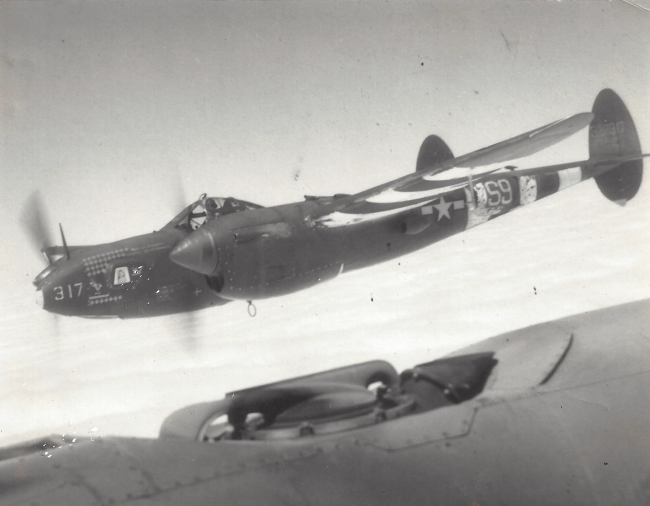RARE! WWII 1943 3rd Photo Reconnaissance Group - 12th Air Force Aerial Reconnaissance Combat Mission Photograph*














RARE! WWII 1943 3rd Photo Reconnaissance Group - 12th Air Force Aerial Reconnaissance Combat Mission Photograph*
Comes with a hand-signed C.O.A.
Mission Date: November 26th, 1943
3rd Reconnaissance Group (12th Air Force) Campaigns: Air Combat, EAME Theater; Tunisia; Sicily; Naples-Foggia; Anzio; Rome-Arno; Southern France; North Apennines; Rhineland; Central Europe; Po Valley.
Decorations. Distinguished Unit Citation: MTO, 28 Aug 1944.
This rare and museum-grade World War II European Theater Allied aerial reconnaissance mission photograph was taken by one of the most decorated Photo Reconnaissance Groups of the European Theater. The U.S. 3rd Reconnaissance Group (12th Air Force) used F4U Corsair and F-5 Lightning aircraft for their aerial recon missions on the ETO.
Provided photographic intelligence that assisted the campaigns for Tunisia, Pantellia, Sardinia, and Sicily. Reconnoitered airdromes, roads, marshaling yards, and harbors both before and after the Allied landings at Salerno. Covered the Anzio area early in 1944 and continued to support the Fifth Army in its drive-through Italy by determining troop movements, gun positions, and terrain. Flew reconnaissance missions in connection with the invasion of Southern France in Aug 1944. Received a DUC for a mission on 28 Aug 1944 when the group provided photographic intelligence that assisted the rapid advance of Allied ground forces. Also mapped areas in France and the Balkans.
This aerial photograph provided Allied commanders, high-ranking officers, and intelligence officials with vital intelligence information that they used to direct future bombing missions and strategical advantages to out-guess the enemy. Thousands of pilots and aircrew throughout the war risked their lives to take photographs such as this one right here. During World War Two, aerial reconnaissance was one of the key methods of obtaining intelligence about the enemy and their activities. Photographs provided concrete evidence - fast.
Within hours of a reconnaissance sortie, the film could be developed, printed, and interpreted. Allied reconnaissance, for the most part, was classified under two main headings: mapping and damage assessment. Enemy activity was recorded and new installations were located, so that accurate maps, to be used by the ground forces, could be made. From damage assessment photographs, the exact moment when a target that had been previously hit should be re-attacked could be calculated, and the effectiveness of the enemy's rebuilding program could be assessed. Photographic reconnaissance and intelligence work played a tremendous role in helping the Allies to victory in World War Two. Significantly, in 1938 General Werner Von Fritsch of the German High Command prophetically observed: 'The military organization with the best aerial reconnaissance will win the next war.'
3rd Photo Reconnaissance Group:
Constituted as 3rd Photographic Group on 9 Jun 1942 and activated on 20 Jun. Redesignated 3rd Photographic Reconnaissance and Mapping Group in May 1943, 3rd Photographic Group (Reconnaissance) in Nov 1943, and 3rd Reconnaissance Group in May 1945. Moved, via England, to the Mediterranean theater, Nov-Dec 1942, and assigned to Twelfth AF. Used F-4 and F-5 aircraft. Provided photographic intelligence that assisted the campaigns for Tunisia, Pantellia, Sardinia, and Sicily. Reconnoitered airdromes, roads, marshaling yards, and harbors both before and after the Allied landings at Salerno. Covered the Anzio area early in 1944 and continued to support the Fifth Army in its drive-through Italy by determining troop movements, gun positions, and terrain. Flew reconnaissance missions in connection with the invasion of Southern France in Aug 1944. Received a DUC for a mission on 28 Aug 1944 when the group provided photographic intelligence that assisted the rapid advance of Allied ground forces. Also mapped areas in France and the Balkans. Inactivated in Italy on 12 Sep 1945. Disbanded on 6 Mar 1947.
Squadrons. 5th: 1942-1945. 12th: 1942-1945. 13th: 1942-1943. 14th: 1942-1943. 15th: 1942-1944. 23d: 1944-1945.
Stations. Colorado Springs, Colo, 20 Jun-13 Aug 1942; Membury, England, 8 Sep 1942; Steeple Morden, England, 26 Oct-22 Nov 1942; La Senia, Algeria, 10 Dec 1942; Algiers, Algeria, 25 Dec 1942; La Marsa, Tunisia, 13 Jun 1943; San Severo, Italy, 8 Dec 1943; Pomigliano, Italy, 4 Jan 1944; Nettuno, Italy, 16 Jun 1944; Viterbo, Italy, 26 Jun 1944; Corsica, c. 14 Jul 1944; Rosia, Italy, c. Sep 1944; Florence, Italy, 17 Jan 1945; Pomigliano, Italy, 26 Aug-12 Sep 1945.
Commanders. Capt George H McBride, 20 Jun 1942; Maj Harry T Eidson, 25 Jun 1942; Maj Elliott Roosevelt, 11 Jul 1942; Lt Col Furman H Limeburner, 13 Aug 1942; Col Elliott Roosevelt, 30 Sep 1942; Lt Col Frank L Dunn, c. Mar 1943; Lt Col James F Setchell, c. 4 Nov 1943; Maj Hal C Tunnell, 19 Jan 1944; Maj Thomas W Barfoot Jr, c. 29 May 1944; Col Duane L Kime, 17 Sep 1944; Lt Col Oscar M Blomquist, 29 May 1945; Lt Col James E Hill, 2 Aug-c. Sep 1945.
Campaigns. Air Combat, EAME Theater; Tunisia; Sicily; Naples-Foggia; Anzio; Rome-Arno; Southern France; North Apennines; Rhineland; Central Europe; Po Valley.
Decorations. Distinguished Unit Citation: MTO, 28 Aug 1944.